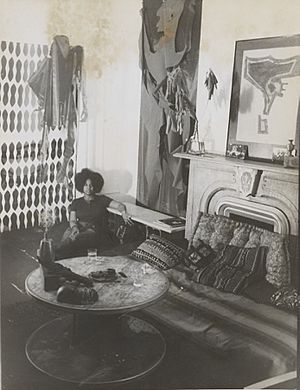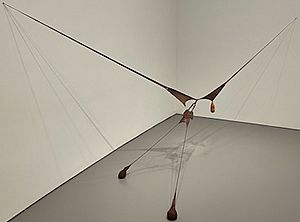Senga Nengudi facts for kids
Quick facts for kids
Senga Nengudi
|
|
|---|---|

Nengudi, circa 1980s
|
|
| Born |
Sue Irons
September 18, 1943 Chicago, Illinois, U.S.
|
| Alma mater | California State University, Los Angeles, Waseda University |
| Occupation | Artist, Sculptor, Curator, Dancer |
| Years active | 1960s–present |
| Known for | Visual art |
| Movement | Studio Z, Performance Art, Sculpture |
| Spouse(s) | Elliott Fittz |
| Awards | Nasher Prize Laureate 2023 |
Senga Nengudi (born Sue Irons on September 18, 1943) is an African-American artist and curator. She is famous for her unique abstract sculptures. These sculptures often combine everyday objects with planned performances. Senga Nengudi is part of a group of groundbreaking African-American artists. They worked in New York City and Los Angeles starting in the 1960s.
In 2023, Nengudi received the Nasher Prize. This award recognized her important contributions to sculpture.
Contents
Early Life and Learning
Senga Nengudi was born Sue Irons in Chicago, Illinois, in 1943. After her father passed away in 1949, she moved to Los Angeles and Pasadena with her mother. Because schools were separated by race back then, Nengudi often had to switch between schools in Los Angeles and Pasadena. Her cousin, Eileen Abdulrashid, is also an artist.
After finishing Dorsey High School, Nengudi studied art and dance. She attended California State University, Los Angeles in the 1960s. She earned her bachelor's degree in 1967. She then spent a year studying at Waseda University in Tokyo, Japan. She wanted to learn about the Gutai Art Association, a group of Japanese artists known for their experimental work.
In 1967, she returned to California State University. She received her Master of Arts degree in sculpture in 1971. While in college in 1965, she worked as an intern at the Watts Towers Art Center. Noah Purifoy was the director there at the time. She also taught art at the Pasadena Art Museum and the Fine Arts Community Workshop.
Soon after, she moved to New York City to continue her art career. She often traveled between New York City and Los Angeles. In 2016, she received an honorary arts degree from Colorado College. Today, she lives and works in Colorado Springs, Colorado with her husband, Elliott Fittz.
Artistic Journey
Nengudi was a key part of the exciting and new Black art scenes. These scenes were active in both New York City and Los Angeles during the 1960s and 1970s. Cheryl Banks was another artist who worked closely with Nengudi. They often shared ideas about their art.
Nengudi worked with two special galleries. One was Pearl C. Woods Gallery in Los Angeles, run by Greg Pitts. The other was Just Above Midtown (JAM) in New York City. Linda Goode Bryant owned and directed JAM, and she greatly influenced Nengudi. Nengudi described working with these galleries as "trying to break down the walls" for Black artists.
Studio Z and Performance Art
In the late 1970s, Nengudi joined an arts program funded by CETA. This program was at Brockman Gallery. There, she met Maren Hassinger. This program helped Nengudi and Hassinger create Ceremony for Freeway Fets. This was a performance with artists like David Hammons and Franklin Parker. They were all part of a group called Studio Z.
Studio Z was also known as the LA Rebellion. This group included African American artists who liked to experiment and create art on the spot. Hammons and Hassinger often worked with Nengudi on her projects. Other members of Studio Z included Ronn Davis, Duval Lewis, RoHo, Barbara McCullough, Houston Conwill, and Joe Ray (artist).
In 1978, Nengudi and Hassinger performed together. They moved freely while tangled inside a large web made of pantyhose. This performance showed how society can limit women. Nengudi also took many staged photographs during this time. She often appeared in them herself as a figure without a clear gender, challenging common ideas.
Artistic Ideas and Themes
Nengudi's art often explores how we classify people by culture, race, and gender. She frequently combines art forms from African, Asian, and Native American cultures. She uses these in her performances and staged photographs. While her work highlights issues of gender, race, and ethnicity, it also shows how these forces affect everyone. Her pieces aim to inspire people from all backgrounds.
She often says that African and Eastern philosophies are the foundation of her work.
Key Artworks
R.S.V.P. Series (1975–1977)

In 1975, after her son was born, Nengudi noticed changes in her body. This inspired her to start her R.S.V.P. series. This series is also known as repondez s’il vous plait (French for "please respond"). It is what she is most famous for. Nengudi combined her interest in movement and sculpture. She created abstract sculptures from everyday objects. These were then used in planned performances, either live or recorded.
The sculptures were made from items like pantyhose. Parts were stretched, twisted, knotted, and filled with sand. These finished sculptures were often hung on gallery walls. They stretched across the space, looking like body parts, such as a mother's womb. Nengudi wanted people to be able to touch them. For her, using pantyhose showed how flexible the human body is, especially a woman's body. These sculptures and her later performances with pantyhose explored feelings, race, body image, and how society affects women's bodies.

When the "R.S.V.P." series first appeared, it did not get much public attention. David Hammons, a close friend and collaborator, explained why. He thought it was because many of Nengudi's pieces from the 1960s and 1970s were abstract. Also, her "R.S.V.P." sculptures were very different from most popular art by her peers in Los Angeles and New York. Some people in New York even felt she was not making "black art."
Nengudi's "R.S.V.P." sculptures have been shown more recently. They appeared in traveling group shows like Now Dig This! Art & Black Los Angeles 1960–1980 (from 2011–2013) and Blues for Smoke (2013).
Ceremony for Freeway Fets (1978)
Nengudi and members of the Studio Z group performed Ceremony for Freeway Fets in 1978. This took place under a freeway overpass on Pico Boulevard in Los Angeles. Nengudi designed costumes and headpieces made of pantyhose for the performers. Hammons and Hassinger played male and female spirits. Nengudi performed as a spirit to bring the genders together. Both the dance and the music, performed by Studio Z members, were made up on the spot.
Warp Trance (2007)
In 2007, Nengudi was an artist-in-residence at The Fabric Workshop and Museum in Philadelphia. This was her first time using video art. She visited textile mills and recorded videos and sounds of the machines working. She also collected objects like Jacquard punch cards. These cards were used to program machines that made textiles.
In her final art piece, Nengudi showed the video footage on a tall screen made of punch cards. The space also had sounds from her audio recordings. This artwork explored ideas about technology, work, modern music, and repeated dance movements.
Poetry and Curating
Besides her sculptures and performances, Nengudi also creates paintings, photographs, and poetry. She has also organized art shows. One example is the solo show for Kira Lynn Harris at the Cue Art Foundation in New York in 2009.
She writes poetry using different names like Harriet Chin, Propecia Lee, and Lily B. Moor. Nengudi explained why she uses these names in an interview. She said she noticed how people judge art based on the artist's name and background. By using different names, she wants people to look at the art itself without any preconceived ideas. She wants to be like a "trickster," playing with ideas and making people see things differently.
Exhibitions and Collections
Nengudi has had many solo art shows. These have been in galleries and museums in the United States and other countries. Some of her solo shows include Senga Nengudi (1971) at California State University, Los Angeles. Others are Vestige: The Discovery of America by Christopher Columbus’ S.D. (1981) at Just Above Midtown Gallery in New York. Also, Warp Trance (2007) at the Pennsylvania Academy of the Fine Arts in Philadelphia.
More recent shows include Senga Nengudi: Improvisational Gestures (2015-2018). This show started at the University of Colorado Colorado Springs Galleries of Contemporary Art. Head Back & High: Senga Nengudi, Performance Objects (1976 – 2015) (2018) began at the Baltimore Museum of Art. And Senga Nengudi: Topologies (2021) was at the Philadelphia Museum of Art.
Nengudi has also been part of many group shows. These include the 57th Venice Biennale in 2017.
Artworks in Public Collections
Many of Senga Nengudi's important artworks are owned by museums and foundations. This means they are part of public collections for everyone to see.
- Water Composition I (1970, remade 2019), Dia Art Foundation, Beacon, New York; and Solomon R. Guggenheim Museum, New York
- R.S.V.P. (1975), Museum of Contemporary Art, Los Angeles
- R.S.V.P. Fall 1976 (1976, remade 2017), Museum of Contemporary Art, Chicago
- R.S.V.P. V (1976), Studio Museum in Harlem, New York
- R.S.V.P. X (1976, remade 2014), Hirshhorn Museum and Sculpture Garden, Smithsonian Institution, Washington, D.C.
- Swing Low (1976, remade 2014), Los Angeles County Museum of Art
- Untitled (1976), Museum of Modern Art, New York
- Inside/Outside (1977), Brooklyn Museum, New York
- Internal I (1977, remade 2014), Whitney Museum, New York
- Internal II (1977, remade 2015), Tate, London
- Performance with "Inside/Outside" (1977), Museum of Modern Art, New York; and Smithsonian American Art Museum, Smithsonian Institution, Washington, D.C.
- R.S.V.P. I (1977, remade 2003), Museum of Modern Art, New York
- R.S.V.P. XI (1977, remade 2004), Carnegie Museum of Art, Pittsburgh
- R.S.V.P. Reverie-"B" Suite (1977, remade 2011), Institute of Contemporary Art, Boston
- Ceremony for Freeway Fets (1978), Museum of Contemporary Art, Los Angeles
- R.S.V.P. Performance Piece (1978, remade 2012), Musée National d'Art Moderne, Paris
- Revery - R (2011), Hammer Museum, Los Angeles
- R.S.V.P. Reverie "Bow Leg" (2014), Museum of Fine Arts, Houston
Images for kids




